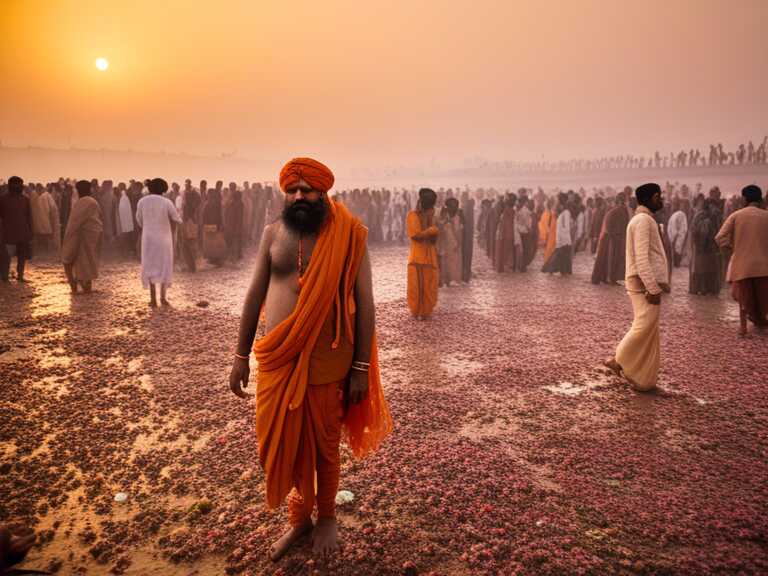
Tragic Stampede at Kumbh Mela Festival Claims Lives of 30 in Prayagraj, India
A stampede at Kumbh Mela in Prayagraj, India, resulted in 30 deaths and numerous injuries during a sacred bathing ritual.

A pre-dawn stampede during the Kumbh Mela religious event in Prayagraj, India, claimed the lives of at least 30 individuals, with numerous others injured. The Kumbh Mela, renowned as the world's largest religious gathering, attracts millions of devotees every 12 years. The stampede occurred as overwhelmed crowds surged out of a police cordon and trampled those nearby.
Stampede at India's Kumbh Mela Hindu mega-festival leaves at least 30 people dead
As devotees rushed to partake in a sacred day of ritual bathing, those resting on the ground near the rivers reported being caught in the chaos of the surging crowd. Eyewitness accounts revealed the harrowing experience of individuals being trampled by the overwhelming mass of pilgrims. Renu Devi, a 48-year-old attendee, recounted the terrifying moment: "The entire crowd fell on top of me, trampling me as it moved forward. When the crowd surged, elderly people and women were crushed, and no one came forward to help."
Rescue teams faced the grim task of carrying victims from the stampede site, navigating through discarded belongings and clothing. Senior police officer Vaibhav Krishna reported, "Thirty devotees have unfortunately died. Ninety injured were taken to the hospital." This update came after hours of uncertainty and was the first official acknowledgment of the tragedy by the authorities.
Continuing Festivities Amidst Tragedy
Despite the devastating incident, the Kumbh Mela festivities continued with millions still participating in the bathing rituals throughout the day. Prime Minister Narendra Modi expressed his grief over the stampede, offering condolences to the families of the deceased and wishing for the swift recovery of the injured. However, anxiety and concern loomed over the relatives of those affected, with many anxiously awaiting news outside a temporary hospital established for the festival.
The Kumbh Mela holds immense significance in the Hindu religious calendar, with the day of the stampede marking one of the holiest occasions. Devotees immerse themselves in the sacred waters at the confluence of the Ganges and Yamuna rivers, in alignment with celestial events. The Kumbh Mela draws its roots from a mythical battle between deities and demons for the nectar of immortality, symbolizing spiritual cleansing and redemption for millions.
Authorities' Response and Safety Measures
In the wake of the stampede, officials attempted to divert crowds from the disaster site, urging devotees to bathe at alternative locations. However, despite these efforts and the spread of news about the incident, the throngs of devotees persisted in their movement towards the river, demonstrating the determination of attendees to partake in the sacred rituals.
Criticism arose regarding the crowd control measures in place, with opposition leader Rahul Gandhi attributing the tragedy to mismanagement and an undue focus on the movement of VIP attendees. Meanwhile, despite concerns over overcrowding in the city, special train services to facilitate pilgrims continued to operate. The authorities had anticipated accommodating up to 400 million visitors before the festival's conclusion on February 26, foreseeing the Kumbh Mela's magnitude akin to a temporary city.
Surveillance and Safety Measures
In a bid to enhance safety, authorities implemented an extensive surveillance network at the festival site and the surrounding areas, incorporating cameras and drones to monitor crowd movements. However, amidst the promises of world-class facilities, the stampede served as a stark reminder of the challenges of ensuring crowd safety during such massive gatherings.
Historical Context and Previous Incidents
The Kumbh Mela has witnessed tragic incidents in the past, with a significant toll recorded in previous editions. The festival in 1954 saw over 400 fatalities due to trampling and drowning, while 36 individuals lost their lives in a stampede during the 2013 event. These historical precedents underscore the critical need for effective crowd management measures and safety protocols to prevent such tragedies in the future.
Share news















